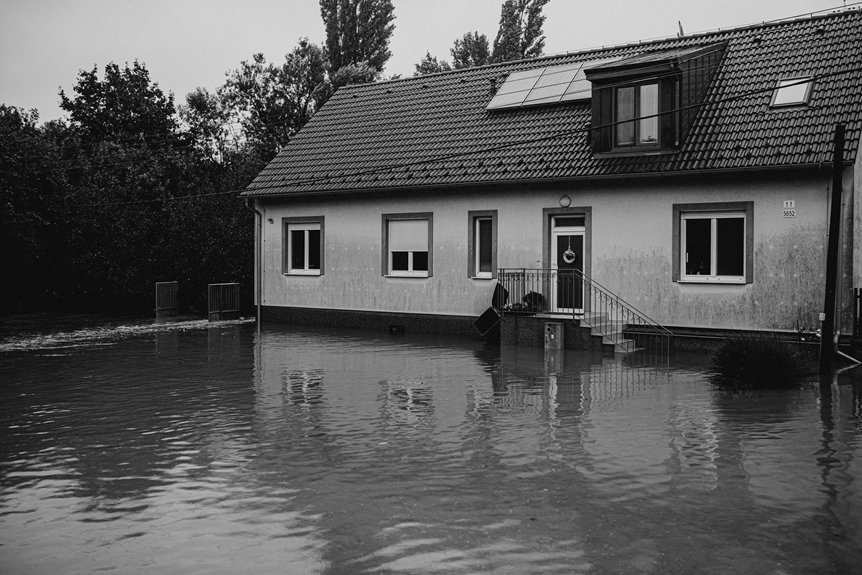After a storm, your first priority is to assess your roof for damage, but knowing how to navigate the insurance claim process can feel overwhelming. From documenting your damage to coordinating with professionals, each step matters to guarantee your claim is successful. Understanding what to do next can help you protect your home and get the repairs you need. Let’s explore how you can effectively file your roof insurance claim and what to expect along the way.
Assessing Storm Damage and Gathering Evidence
After a storm, it’s essential to promptly assess your roof for damage and gather evidence to support your insurance claim. Look closely for signs of hail damage, such as dented shingles, cracked surfaces, or bruising. Wind destruction might cause missing or displaced shingles, curling edges, or damaged flashing. Take clear, detailed photos from different angles, focusing on affected areas. Document any visible hail damage or wind destruction, and note the date and time of the storm. Keep a record of any fallen debris or leaks inside your home, as these can reinforce your claim. Acting quickly ensures you capture the damage before it worsens and provides your insurance company with solid evidence to support your case. Prompt action can make a significant difference in processing your claim efficiently.
Contacting Your Insurance Company Promptly
Timely communication with your insurance company is essential once you’ve assessed the damage. Call your insurer promptly to notify them of the storm’s impact and start the claims process. Be prepared to use insurance jargon, clearly describing the damage and referencing policy details.
When speaking with your adjuster, ask about common claim denial reasons, such as insufficient documentation or late reporting, to avoid pitfalls. Keep detailed notes of your conversations, including dates and names.
Prompt contact helps ensure your claim is processed efficiently and reduces the risk of delays or denials. Remember, insurance companies prioritize timely reports, so don’t delay reaching out—acting quickly can make all the difference in securing coverage for your roof repairs.
Documenting Damage and Completing the Claim Form
To guarantee your claim is successful, start by thoroughly documenting the damage to your roof. Take clear photos and videos from multiple angles, highlighting storm-related issues like missing shingles or leaks.
Keep a detailed record of any roof maintenance you’ve done recently, as this can help differentiate storm damage from normal wear.
Next, review your insurance policy to understand coverage limits and specific requirements for claims.
When completing the claim form, provide accurate, detailed descriptions of the damage, including dates and circumstances.
Attach your visual documentation and any relevant receipts for repairs or maintenance.
Staying organized and precise ensures your claim is processed smoothly and increases your chances of a fair settlement.
Scheduling an Inspection With a Professional Adjuster
Scheduling an inspection with a professional adjuster is a crucial step to guarantee your claim is accurately evaluated. Your insurance policy likely requires an adjuster’s assessment to verify storm damage and determine coverage.
By scheduling this inspection promptly, you ensure your damages are documented thoroughly, preventing potential claim denial due to incomplete or inaccurate information. Be prepared to show the extent of roof damage and provide any supporting documentation you’ve gathered.
Keep in mind that delaying the inspection might lead to questions about the damage’s timing or validity, risking a claim denial. Working with a licensed adjuster helps clarify your coverage and ensures your claim aligns with your policy’s terms, increasing the likelihood of a smooth and successful claims process.
Understanding the Claims Process and Following Up
After arranging the inspection with the adjuster, understanding what happens next in the claims process helps you stay on track. Review your insurance policy terms carefully so you know what’s covered and can identify any claim denial reasons if your claim is denied.
The insurance company will evaluate the adjuster’s report and determine whether to approve, deny, or delay your claim. It’s important to follow up regularly to ensure your claim progresses smoothly.
If your claim is denied, request a clear explanation and review the denial reasons closely. You can appeal or provide additional documentation to support your case.
Staying proactive and informed helps you navigate the process efficiently and get the settlement you deserve.
Conclusion
Filing a roof insurance claim after a storm may seem daunting, but staying organized and acting quickly makes it manageable. Assess your damage, gather strong evidence, and contact your insurer promptly. Schedule a professional inspection to verify all issues are documented accurately—For more information on how to schedule your free roof inspection, call us at (405) 543-2920 or visit us online at Top View Roofing. Keep track of your communication and review your policy details carefully. By staying proactive and diligent, you’ll help guarantee a smooth claim process and get your roof repaired as soon as possible.











